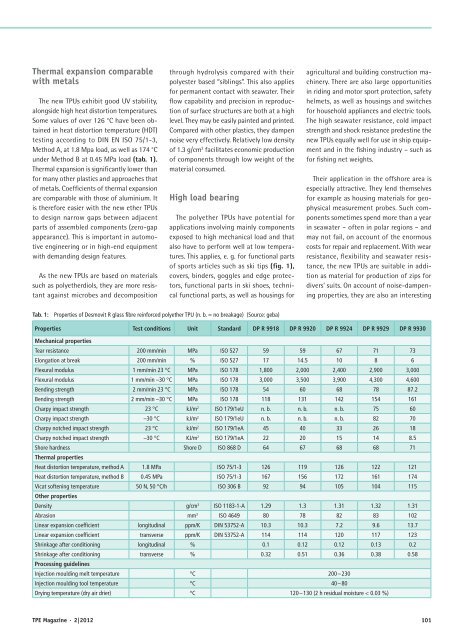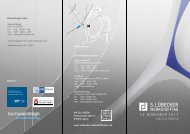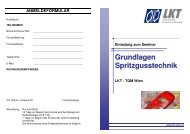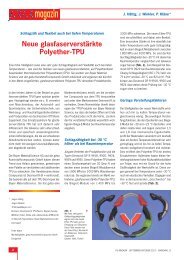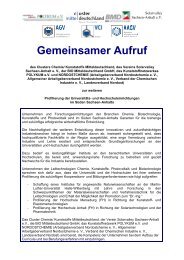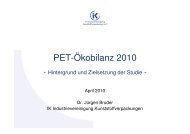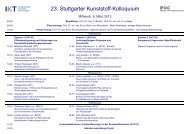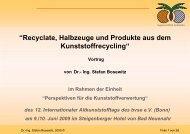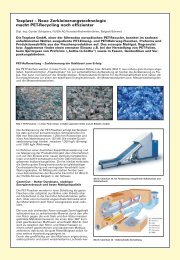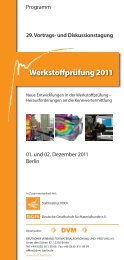New glass fibre reinforced polyether TPUs - Plasticker
New glass fibre reinforced polyether TPUs - Plasticker
New glass fibre reinforced polyether TPUs - Plasticker
You also want an ePaper? Increase the reach of your titles
YUMPU automatically turns print PDFs into web optimized ePapers that Google loves.
Thermal expansion comparable<br />
with metals<br />
The new <strong>TPUs</strong> exhibit good UV stability,<br />
alongside high heat distortion temperatures.<br />
Some values of over 126 °C have been obtained<br />
in heat distortion temperature (HDT)<br />
testing according to DIN EN ISO 75/1-3,<br />
Method A, at 1.8 Mpa load, as well as 174 °C<br />
under Method B at 0.45 MPa load (tab. 1).<br />
Thermal expansion is signifi cantly lower than<br />
for many other plastics and approaches that<br />
of metals. Coeffi cients of thermal expansion<br />
are comparable with those of aluminium. It<br />
is therefore easier with the new ether <strong>TPUs</strong><br />
to design narrow gaps between adjacent<br />
parts of assembled components (zero-gap<br />
appearance). This is important in automotive<br />
engineering or in high-end equipment<br />
with demanding design features.<br />
As the new <strong>TPUs</strong> are based on materials<br />
such as <strong>polyether</strong>diols, they are more resistant<br />
against microbes and decomposition<br />
through hydrolysis compared with their<br />
polyester based “siblings”. This also applies<br />
for permanent contact with seawater. Their<br />
fl ow capability and precision in reproduction<br />
of surface structures are both at a high<br />
level. They may be easily painted and printed.<br />
Compared with other plastics, they dampen<br />
noise very effectively. Relatively low density<br />
of 1.3 g/cm 3 facilitates economic production<br />
of components through low weight of the<br />
material consumed.<br />
High load bearing<br />
The <strong>polyether</strong> <strong>TPUs</strong> have potential for<br />
applications involving mainly components<br />
exposed to high mechanical load and that<br />
also have to perform well at low temperatures.<br />
This applies, e. g. for functional parts<br />
of sports articles such as ski tips (fi g. 1),<br />
covers, binders, goggles and edge protectors,<br />
functional parts in ski shoes, technical<br />
functional parts, as well as housings for<br />
Tab. 1: Properties of Desmovit R <strong>glass</strong> fi bre <strong>reinforced</strong> <strong>polyether</strong> TPU (n. b. = no breakage) (Source: geba)<br />
agricultural and building construction machinery.<br />
There are also large opportunities<br />
in riding and motor sport protection, safety<br />
helmets, as well as housings and switches<br />
for household appliances and electric tools.<br />
The high seawater resistance, cold impact<br />
strength and shock resistance predestine the<br />
new <strong>TPUs</strong> equally well for use in ship equipment<br />
and in the fi shing industry – such as<br />
for fi shing net weights.<br />
Their application in the offshore area is<br />
especially attractive. They lend themselves<br />
for example as housing materials for geophysical<br />
measurement probes. Such components<br />
sometimes spend more than a year<br />
in seawater – often in polar regions – and<br />
may not fail, on account of the enormous<br />
costs for repair and replacement. With wear<br />
resistance, fl exibility and seawater resistance,<br />
the new <strong>TPUs</strong> are suitable in addition<br />
as material for production of zips for<br />
divers’ suits. On account of noise-dampening<br />
properties, they are also an interesting<br />
Properties Test conditions Unit Standard DP R 9918 DP R 9920 DP R 9924 DP R 9929 DP R 9930<br />
Mechanical properties<br />
Tear resistance 200 mm/min MPa ISO 527 59 59 67 71 73<br />
Elongation at break 200 mm/min % ISO 527 17 14.5 10 8 6<br />
Flexural modulus 1 mm/min 23 °C MPa ISO 178 1,800 2,000 2,400 2,900 3,000<br />
Flexural modulus 1 mm/min –30 °C MPa ISO 178 3,000 3,500 3,900 4,300 4,600<br />
Bending strength 2 mm/min 23 °C MPa ISO 178 54 60 68 78 87.2<br />
Bending strength 2 mm/min –30 °C MPa ISO 178 118 131 142 154 161<br />
Charpy impact strength 23 °C kJ/m2 ISO 179/1eU n. b. n. b. n. b. 75 60<br />
Charpy impact strength –30 °C kJ/m2 ISO 179/1eU n. b. n. b. n. b. 82 70<br />
Charpy notched impact strength 23 °C kJ/m2 ISO 179/1eA 45 40 33 26 18<br />
Charpy notched impact strength –30 °C KJ/m2 ISO 179/1eA 22 20 15 14 8.5<br />
Shore hardness<br />
Thermal properties<br />
Shore D ISO 868 D 64 67 68 68 71<br />
Heat distortion temperature, method A 1.8 MPa ISO 75/1-3 126 119 126 122 121<br />
Heat distortion temperature, method B 0.45 MPa ISO 75/1-3 167 156 172 161 174<br />
Vicat softening temperature<br />
Other properties<br />
50 N, 50 °C/h ISO 306 B 92 94 105 104 115<br />
Density g/cm3 ISO 1183-1-A 1.29 1.3 1.31 1.32 1.31<br />
Abrasion mm3 ISO 4649 80 78 82 83 102<br />
Linear expansion coeffi cient longitudinal ppm/K DIN 53752-A 10.3 10.3 7.2 9.6 13.7<br />
Linear expansion coeffi cient transverse ppm/K DIN 53752-A 114 114 120 117 123<br />
Shrinkage after conditioning longitudinal % 0.1 0.12 0.12 0.13 0.2<br />
Shrinkage after conditioning<br />
Processing guidelines<br />
transverse % 0.32 0.51 0.36 0.38 0.58<br />
Injection moulding melt temperature °C 200 – 230<br />
Injection moulding tool temperature °C 40 – 80<br />
Drying temperature (dry air drier) °C 120 – 130 (2 h residual moisture < 0.03 %)<br />
TPE Magazine · 2|2012 101


